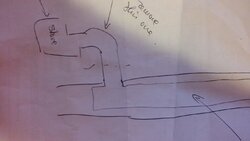I purchased my Soot-Eater two years ago shortly after having the stove and chimney installed, along with two additional sets of rods since my chimney is approximately 26' tall. It is a prefabricated 6" double-wall insulated stainless steel chimney, with clean-out tee at the bottom. The tee cover is low to the ground, only 21" above the floor.
Although I have had only about 1/8" of soot and creosote build-up each time I have used it, the SootEater appeared to clean everything right down to the metal, except for a dark-brown patina (which is good, since bright shiny metal would have indicated possible scratching or abrasion of the stainless steel surface, something the manufacturer clearly warns against). I use the device twice per season, once in mid-season and again at the end of burning season. Although the manual strongly recommends that it is no substitute for an annual inspection/cleaning by a certified chimney sweep, I suspect this is a disclaimer for liability purposes. If it gets the chimney this clean at the end of season, I see no need for the services of a chimney sweep, except maybe once every couple of years to inspect the condition of the chimney near the top for any possible need for repairs if one prefers not to climb on the roof . I had a professional sweep to clean and inspect the chimney after the second season and he said everything looked good.
My unit and the extra rods I purchased are black, as opposed to the white rods shown in the video. I suspect they added the black outer jacket to protect the flexible rod from abrasion, but this appears to make the rod stiffer and a little harder to manage than the one shown in the video. I was not able to completely clean the bottom 2-3 feet of the chimney because the rod was too stiff to properly make the bend into the first couple of feet, even though I managed to follow their recommendation to maintain less than 90 degrees of bend in the rod. I may try a regular plastic brush with a short rod to clean the very bottom. A shortened version of their flexible rod would also work, to allow the drill to face straight up vertically into the chimney without the bend in the rod, while cleaning the first few feet.
Last time I used it, I think I held the device in one place too long while the drill was turning, and one of the rods at the bend broke in two right where I was holding it in position with my gloved hand. I think the secret is to maintain a constant up-and-down motion at all times while the drill is turning. My chimney cut-out is low enough to the floor that it is difficult to avoid approaching the 90 degree limit at the bend.
The plastic sheet the manufacturer provided for sealing off the hole while cleaning was totally useless. At first I tried cleaning without using anything to stop up the hole, letting the soot/creosote drop into a pan on the floor below. This was a little messy, but the main problem was that the rod would inevitably come in contact with the chimney at the opening of the tee, and the sharp edge of the interior sheet metal sleeve cut deeply into the outer jacket of the rod, and would have severely damaged each rod had I continued. Instead, I stopped and cut out a round disc the same size as the tee cover from a piece of scrap 1/2" plywood, drilled a slightly eccentric hole in the plywood large enough to pass the rod through, and fashioned a bracket to hold the disc in place at the bottom of the tee during the cleaning operation. This keeps the rotating rod spaced towards the centre of the entrance at the tee as it bends up into the chimney. The wood still leaves visible surface marks on the outer jacket of the rod, but doesn't cut into the black plastic sleeve the way the bare edge of the sheet metal did. The entire cleaning process takes less than an hour and leaves minimal mess when I remove the wooden disc and let the soot fall into the pan.
I believe the red trimmer string they use on the cleaning head is the same stuff used with a regular string-trimmer for lawn work, which I plan to try when it comes time to replace the string. It would be cheaper and available locally instead of having to wait for an order to arrive.
The SootEater is a good product, allowing routine cleaning multiple times during heating season with minimal time and cost, but someone who is knowledgeable and handy with a few basic shop tools will be more likely to have a satisfactory outcome.
Don


